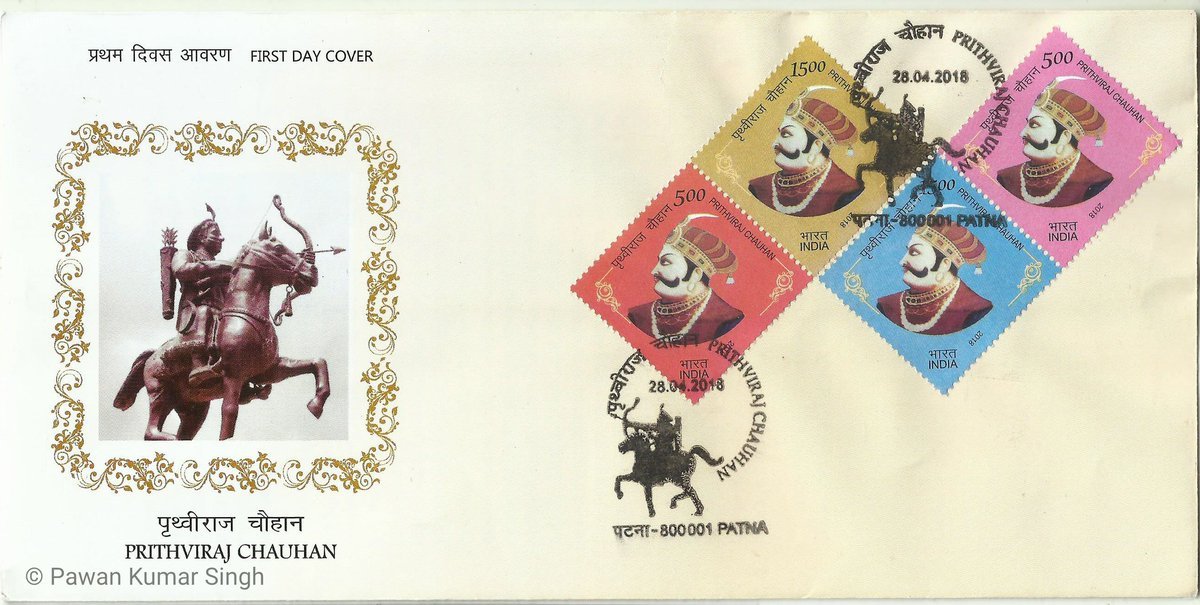Prithviraj Chauhan

Technical Data
| Stamp Set | Prithviraj Chauhan |
|---|---|
| Date of Issue | April 28, 2018 |
| Denomination | Rs. 15 |
| Quantity | 500,000 |
| Perforation | 13¾ x 13¾ |
| Printer | Security Printing Press, Hyderabad |
| Printing Process | Wet Offset |
| Watermark | No Watermark |
| Colors | Multicolor |
| Credit (Designed By) | Smt. Alka Sharma |
| Catalog Codes |
Michel IN 3386 |
| Themes | Commemoration | Famous people | Kings | Men |
The Last Rajput King Who Defended India’s Honour
Among the many heroic figures of medieval India, Prithviraj Chauhan (1178–1192 CE) stands out as a symbol of unmatched courage, chivalry, and patriotism. Immortalized in folklore as Rai Pithora, he was one of the last great Rajput rulers to resist the foreign invasions that changed the course of India’s history.
Born into the Chahamana (Chauhan) dynasty, Prithviraj ruled over Sapadalaksha, a vast and powerful kingdom that covered much of present-day Rajasthan, Haryana, and Delhi, and extended into parts of Madhya Pradesh and Uttar Pradesh. His capital, Ajayameru (modern Ajmer), became a centre of culture, learning, and Rajput valor. Though medieval ballads often call him the King of Delhi, his influence and legacy spread far beyond.
The Making of a King
Prithviraj was born to King Someshvara and Queen Karpuradevi, rulers of the Chahamana dynasty. When his father passed away in 1177 CE, the young prince, barely eleven years old, ascended the throne. Under the guidance of his mother and a regency council, the young ruler quickly displayed intelligence, military prowess, and a deep sense of justice — qualities that would later define his reign.
As Prithviraj matured, so did his kingdom’s strength. He united the Rajput chiefs under his leadership, defending his realm with unmatched skill and strategic brilliance. His name became synonymous with honor, courage, and dharma — the very principles that guided Rajput warfare.
The Clash of Empires – Battles of Tarain
By the late 12th century, a new power was rising in the northwest — Muhammad of Ghori, the ruler of Ghazni, who sought to expand his empire eastward into India. The inevitable confrontation came when Ghori captured Tabarhindah (modern Bhatinda or Sirhind) in 1190 CE.
Hearing of this, Prithviraj Chauhan gathered his army and allies, including Govindaraja of Delhi, and marched to confront the invader. The two forces met on the plains of Tarain (Taraori) in 1191 CE, resulting in a fierce battle. With his brilliant cavalry tactics and fearless warriors, Prithviraj achieved a decisive victory.
Muhammad of Ghori was gravely injured and forced to retreat, narrowly escaping capture. Yet, in keeping with Rajput codes of honor, Prithviraj refused to attack the retreating enemy — a decision that reflected his nobility, though it would later change the fate of India.
The Second Battle of Tarain and the Fall of a Hero
Determined to avenge his defeat, Ghori returned in 1192 CE with a massive, well-equipped army of 120,000 soldiers, including Afghan, Tajik, and Turkic horsemen. This time, he came prepared with a strategy of deception.
Ghori divided his troops into four units, each with 10,000 archers, and launched a surprise dawn attack on Prithviraj’s camp. Pretending to retreat, they lured the Rajput army into pursuit, exhausting them under the hot sun. Then, with his reserve forces, Ghori struck back, surrounding and overwhelming the Chahamana army.
Prithviraj fought valiantly until the end but was ultimately captured near Sarasvati Fort (modern Sirsa). His defeat marked not just the fall of a mighty king, but also the end of Rajput dominance in northern India. His courage, however, continued to echo through generations as the embodiment of valor, sacrifice, and national pride.
A Timeless Legacy Honored in Philately
The Commemorative Postage Stamp on Prithviraj Chauhan celebrates the life of a monarch whose bravery and leadership remain an integral part of India’s historical and cultural memory. Through this stamp, the Department of Posts pays tribute to the last Hindu ruler of Delhi, whose story is not merely a tale of battle and loss, but of honor, resilience, and patriotism.
The image of Prithviraj Chauhan on the stamp evokes an age when kings fought not for conquest, but for principle and pride — a legacy that continues to inspire every Indian.
First Day Cover

